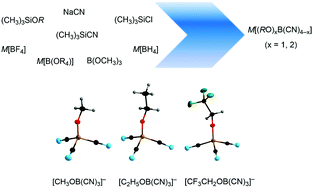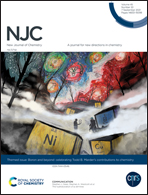Abstract
Syntheses of alkoxytricyanoborates and dialkoxydicyanoborates are described using different readily available boron-based starting compounds such as tetrahydrido-, tetrafluoro-, and tetraalkoxyborates, as well as trimethoxyborane and trimethylsilylcyanide as cyano sources. The salts obtained have been characterized by NMR and vibrational spectroscopy, elemental analysis, and DSC and DTA measurements. In addition to alkali metal salts, room temperature ionic liquids [EMIm][ROB(CN)3] (R = CH3, C2H5, CH2CF3) have been prepared. These ionic liquids exhibit very low melting points or glass transition temperatures, low viscosities, and high chemical, thermal, and electrochemical stabilities. The influence of alkyl chain length and the effect of partial fluorination of the alkoxy group on these properties have been elucidated. The advantageous physicochemical properties, in general, and in conjunction with the easy accessibility make alkoxytricyanoborate-ILs interesting compounds for potential applications in materials sciences. Furthermore, the Li salt of the [CH3OB(CN)3]− ions was prepared and found to provide a significantly higher solubility in propylene carbonate compared to lithium tetracyanoborate. Alkali metal salts Li[CH3OB(CN)3]·H2O, Na[CH3OB(CN)3]·H2O, K[CH3OB(CN)3], Na[C2H5OB(CN)3], and Na[CF3CH2OB(CN)3]·0.5H2O have been characterized by single-crystal X-ray diffraction.

- This article is part of the themed collection: Boron & Beyond - in celebration of Todd Marder


 Please wait while we load your content...
Please wait while we load your content...